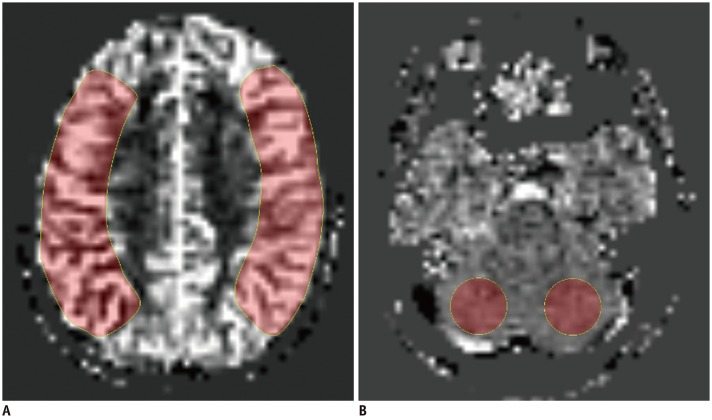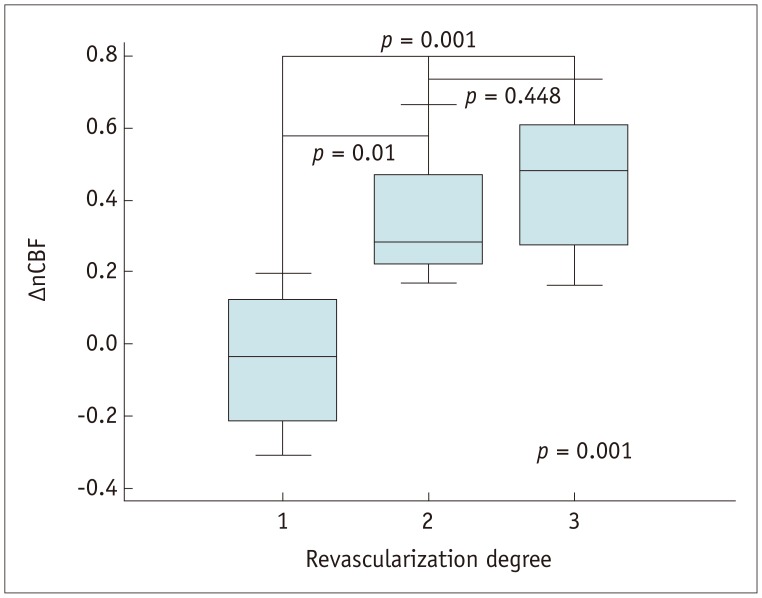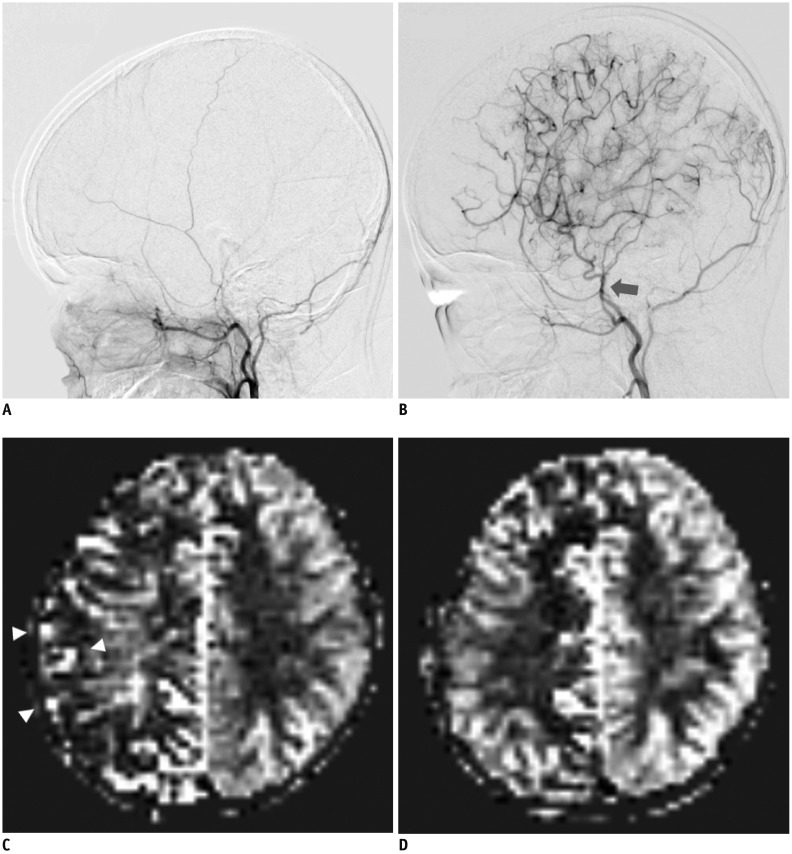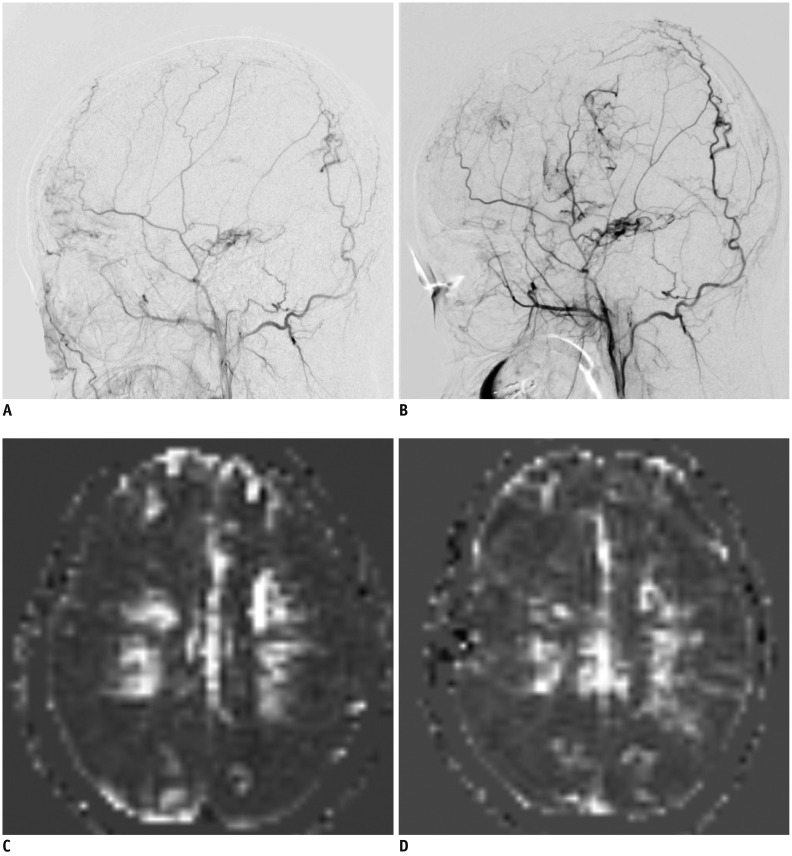Korean J Radiol.
2019 Jun;20(6):985-996. 10.3348/kjr.2018.0651.
Arterial Spin Labeling MRI for Quantitative Assessment of Cerebral Perfusion Before and After Cerebral Revascularization in Children with Moyamoya Disease
- Affiliations
-
- 1Department of Radiology, Gyeongsang National University Changwon Hospital, Changwon, Korea.
- 2Department of Radiology, Seoul National University Hospital, Seoul, Korea. choiyounghun@gmail.com
- 3Department of Radiology, Seoul National University College of Medicine, Seoul, Korea.
- 4Institute of Radiation Medicine, Seoul National University Medical Research Center, Seoul, Korea.
- KMID: 2447077
- DOI: http://doi.org/10.3348/kjr.2018.0651
Abstract
OBJECTIVE
To determine the correlation between cerebral blood flow (CBF) on arterial spin labeling (ASL) MRI and the degree of postoperative revascularization assessed on digital subtraction angiography in children with moyamoya disease (MMD).
MATERIALS AND METHODS
Twenty-one children (9 boys and 12 girls; mean age, 8.4 ± 3.6 years; age range, 3-16 years) with MMD who underwent both pseudocontinuous ASL MRI at 1.5T and catheter angiography before and after superficial temporal artery encephaloduroarteriosynangiosis were included in this retrospective study. The degree of revascularization in the middle cerebral artery (MCA) territory was evaluated on external carotid angiography and was graded on a 3-point scale. On ASL CBF maps, regions of interest were manually drawn over the MCA territory of the operated side at the level of the centrum semi-ovale and over the cerebellum. The normalized CBF (nCBF) was calculated by dividing the CBF of the MCA territory by the CBF of the cerebellum. Changes in nCBFs were calculated by subtracting the preoperative nCBF values from the postoperative nCBF values. The correlation between nCBF changes measured with ASL and the revascularization grade from direct angiography was evaluated.
RESULTS
The nCBF value on the operated side increased after the operation (p = 0.001). The higher the degree of revascularization, the greater the nCBF change was: poor revascularization (grade 1), −0.043 ± 0.212; fair revascularization (grade 2), 0.345 ± 0.176; good revascularization (grade 3), 0.453 ± 0.182 (p = 0.005, Jockheere-Terpstra test). The interobserver agreement was excellent for the measured CBF values of the three readers (0.91-0.97).
CONCLUSION
The nCBF values of the MCA territory obtained from ASL MRI increased after the revascularization procedure in children with MMD, and the degree of nCBF change showed a significant correlation with the degree of collateral formation evaluated via catheter angiography.
Keyword
MeSH Terms
Figure
Reference
-
1. Kuroda S, Houkin K. Moyamoya disease: current concepts and future perspectives. Lancet Neurol. 2008; 7:1056–1066. PMID: 18940695.
Article3. Research Committee on the Pathology and Treatment of Spontaneous Occlusion of the Circle of Willis. Health Labour Sciences Research Grant for Research on Measures for Infractable Diseases. Guidelines for diagnosis and treatment of moyamoya disease (spontaneous occlusion of the circle of Willis). Neurol Med Chir (Tokyo). 2012; 52:245–266. PMID: 22870528.4. Yun TJ, Cheon JE, Na DG, Kim WS, Kim IO, Chang KH, et al. Childhood moyamoya disease: quantitative evaluation of perfusion MR imaging--correlation with clinical outcome after revascularization surgery. Radiology. 2009; 251:216–223. PMID: 19332853.
Article5. Kim T, Oh CW, Bang JS, Kim JE, Cho WS. Moyamoya disease: treatment and outcomes. J Stroke. 2016; 18:21–30. PMID: 26846757.
Article6. Matsushima T, Inoue T, Suzuki SO, Fujii K, Fukui M, Hasuo K. Surgical treatment of moyamoya disease in pediatric patients--comparison between the results of indirect and direct revascularization procedures. Neurosurgery. 1992; 31:401–405. PMID: 1407421.
Article7. Patel NN, Mangano FT, Klimo P Jr. Indirect revascularization techniques for treating moyamoya disease. Neurosurg Clin N Am. 2010; 21:553–563. PMID: 20561503.
Article8. Park JH, Yang SY, Chung YN, Kim JE, Kim SK, Han DH, et al. Modified encephaloduroarteriosynangiosis with bifrontal encephalogaleoperiosteal synangiosis for the treatment of pediatric moyamoya disease. Technical note. J Neurosurg. 2007; 106:237–242. PMID: 17465392.9. Hasuo K, Tamura S, Kudo S, Uchino A, Carlos R, Matsushima T, et al. Moya moya disease: use of digital subtraction angiography in its diagnosis. Radiology. 1985; 157:107–111. PMID: 3898215.
Article10. Calamante F, Ganesan V, Kirkham FJ, Jan W, Chong WK, Gadian DG, et al. MR perfusion imaging in moyamoya syndrome: potential implications for clinical evaluation of occlusive cerebrovascular disease. Stroke. 2001; 32:2810–2816. PMID: 11739978.11. Tibussek D, Rademacher C, Caspers J, Turowski B, Schaper J, Antoch G, et al. Gadolinium brain deposition after macrocyclic gadolinium administration: a pediatric case-control study. Radiology. 2017; 285:223–230. PMID: 28640695.12. Mithal LB, Patel PS, Mithal D, Palac HL, Rozenfeld MN. Use of gadolinium-based magnetic resonance imaging contrast agents and awareness of brain gadolinium deposition among pediatric providers in North America. Pediatr Radiol. 2017; 47:657–664. PMID: 28283727.
Article13. Zhang J, Wang J, Geng D, Li Y, Song D, Gu Y. Whole-brain CT perfusion and CT angiography assessment of moyamoya disease before and after surgical revascularization: preliminary study with 256-slice CT. PLoS One. 2013; 8:e57595. PMID: 23451248.
Article14. Proisy M, Bruneau B, Rozel C, Tréguier C, Chouklati K, Riffaud L, et al. Arterial spin labeling in clinical pediatric imaging. Diagn Interv Imaging. 2016; 97:151–158. PMID: 26456912.
Article15. Haller S, Zaharchuk G, Thomas DL, Lovblad KO, Barkhof F, Golay X. Arterial spin labeling perfusion of the brain: emerging clinical applications. Radiology. 2016; 281:337–356. PMID: 27755938.
Article16. Sugino T, Mikami T, Miyata K, Suzuki K, Houkin K, Mikuni N. Arterial spin-labeling magnetic resonance imaging after revascularization of moyamoya disease. J Stroke Cerebrovasc Dis. 2013; 22:811–816. PMID: 22721824.
Article17. Zaharchuk G, Do HM, Marks MP, Rosenberg J, Moseley ME, Steinberg GK. Arterial spin-labeling MRI can identify the presence and intensity of collateral perfusion in patients with moyamoya disease. Stroke. 2011; 42:2485–2491. PMID: 21799169.
Article18. Hara S, Tanaka Y, Ueda Y, Hayashi S, Inaji M, Ishiwata K, et al. Noninvasive evaluation of CBF and perfusion delay of moyamoya disease using arterial spin-labeling MRI with multiple postlabeling delays: comparison with 15O-Gas PET and DSC-MRI. AJNR Am J Neuroradiol. 2017; 38:696–702. PMID: 28209582.19. Wang R, Yu S, Alger JR, Zuo Z, Chen J, Wang R, et al. Multi-delay arterial spin labeling perfusion MRI in moyamoya disease--comparison with CT perfusion imaging. Eur Radiol. 2014; 24:1135–1144. PMID: 24557051.
Article20. Goetti R, O'Gorman R, Khan N, Kellenberger CJ, Scheer I. Arterial spin labelling MRI for assessment of cerebral perfusion in children with moyamoya disease: comparison with dynamic susceptibility contrast MRI. Neuroradiology. 2013; 55:639–647. PMID: 23404242.
Article21. Matsushima T, Fujiwara S, Nagata S, Fujii K, Fukui M, Kitamura K, et al. Surgical treatment for paediatric patients with moyamoya disease by indirect revascularization procedures (EDAS, EMS, EMAS). Acta Neurochir (Wien). 1989; 98:135–140. PMID: 2741743.
Article22. Wu WC, Fernández-Seara M, Detre JA, Wehrli FW, Wang J. A theoretical and experimental investigation of the tagging efficiency of pseudocontinuous arterial spin labeling. Magn Reson Med. 2007; 58:1020–1027. PMID: 17969096.
Article23. Wang J, Zhang Y, Wolf RL, Roc AC, Alsop DC, Detre JA. Amplitude-modulated continuous arterial spin-labeling 3.0-T perfusion MR imaging with a single coil: feasibility study. Radiology. 2005; 235:218–228. PMID: 15716390.
Article24. Wang Z, Aguirre GK, Rao H, Wang J, Fernández-Seara MA, Childress AR, et al. Empirical optimization of ASL data analysis using an ASL data processing toolbox: ASLtbx. Magn Reson Imaging. 2008; 26:261–269. PMID: 17826940.
Article25. Tatu L, Moulin T, Bogousslavsky J, Duvernoy H. Arterial territories of the human brain: cerebral hemispheres. Neurology. 1998; 50:1699–1708. PMID: 9633714.
Article26. Robertson RL, Burrows PE, Barnes PD, Robson CD, Poussaint TY, Scott RM. Angiographic changes after pial synangiosis in childhood moyamoya disease. AJNR Am J Neuroradiol. 1997; 18:837–845. PMID: 9159360.27. Houkin K, Nakayama N, Kuroda S, Ishikawa T, Nonaka T. How does angiogenesis develop in pediatric moyamoya disease after surgery? A prospective study with MR angiography. Childs Nerv Syst. 2004; 20:734–741. PMID: 15197570.28. Kim SK, Seol HJ, Cho BK, Hwang YS, Lee DS, Wang KC. Moyamoya disease among young patients: its aggressive clinical course and the role of active surgical treatment. Neurosurgery. 2004; 54:840–844. discussion 844-846. PMID: 15046649.
Article29. Yoon HK, Shin HJ, Lee M, Byun HS, Na DG, Han BK. MR angiography of moyamoya disease before and after encephal oduroarteriosynangiosis. AJR Am J Roentgenol. 2000; 174:195–200. PMID: 10628478.30. So Y, Lee HY, Kim SK, Lee JS, Wang KC, Cho BK, et al. Prediction of the clinical outcome of pediatric moyamoya disease with postoperative basal/acetazolamide stress brain perfusion SPECT after revascularization surgery. Stroke. 2005; 36:1485–1489. PMID: 15947261.
Article31. Ikezaki K, Matsushima T, Kuwabara Y, Suzuki SO, Nomura T, Fukui M. Cerebral circulation and oxygen metabolism in childhood moyamoya disease: a perioperative positron emission tomography study. J Neurosurg. 1994; 81:843–850. PMID: 7965114.
Article32. Saida T, Masumoto T, Nakai Y, Shiigai M, Matsumura A, Minami M. Moyamoya disease: evaluation of postoperative revascularization using multiphase selective arterial spin labeling MRI. J Comput Assist Tomogr. 2012; 36:143–149. PMID: 22261785.33. Yun TJ, Paeng JC, Sohn CH, Kim JE, Kang HS, Yoon BW, et al. Monitoring cerebrovascular reactivity through the use of arterial spin labeling in patients with moyamoya disease. Radiology. 2016; 278:205–213. PMID: 26197057.
Article34. Goetti R, Warnock G, Kuhn FP, Guggenberger R, O'Gorman R, Buck A, et al. Quantitative cerebral perfusion imaging in children and young adults with moyamoya disease: comparison of arterial spin-labeling-MRI and H2[15O]-PET. AJNR Am J Neuroradiol. 2014; 35:1022–1028. PMID: 24335546.
Article35. Blauwblomme T, Lemaitre H, Naggara O, Calmon R, Kossorotoff M, Bourgeois M, et al. Cerebral blood flow improvement after indirect revascularization for pediatric moyamoya disease: a statistical analysis of arterial spin-labeling MRI. AJNR Am J Neuroradiol. 2016; 37:706–712. PMID: 26585258.
Article36. Lee S, Yun TJ, Yoo RE, Yoon BW, Kang KM, Choi SH, et al. Monitoring cerebral perfusion changes after revascularization in patients with moyamoya disease by using arterial spin-labeling MR imaging. Radiology. 2018; 288:565–572. PMID: 29714677.37. Lee M, Zaharchuk G, Guzman R, Achrol A, Bell-Stephens T, Steinberg GK. Quantitative hemodynamic studies in moyamoya disease: a review. Neurosurg Focus. 2009; 26:E5.38. Roach BA, Donahue MJ, Davis LT, Faraco CC, Arteaga D, Chen SC, et al. Interrogating the functional correlates of collateralization in patients with intracranial stenosis using multimodal hemodynamic imaging. AJNR Am J Neuroradiol. 2016; 37:1132–1138. PMID: 27056428.
Article
- Full Text Links
- Actions
-
Cited
- CITED
-
- Close
- Share
- Similar articles
-
- Monitoring Cerebral Perfusion Changes Using Arterial Spin-Labeling Perfusion MRI after Indirect Revascularization in Children with Moyamoya Disease
- Indirect revascularization surgery for moyamoya disease in children and its special considerations
- Arterial Spin Labeling Perfusion MRI Signal Processing Through Traditional Methods and Machine Learning
- Update of Moyamoya Disease
- Diagnosis and Treatment of Moyamoya Disease





